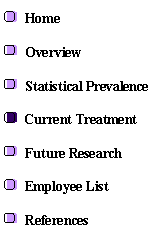

|
Initial diagnosis is made based on the observation of histological data exhibiting multi-nucleated giant cells, powdery chromatin, micronuclei, psamoma bodies and overlapping nuclei [5]. Subsequent Resection involves the partial or total removal of the thyroid. Although survival rate of PTC, FTC and MTC are relatively such that many hospitals opt for partial thyroidectomy. Thyroid cancer, however is often multi-focal and total resection is recommended to reduce recurrence risk [14, 15]. To assess possible metastasis dissection of the bilateral cervical lymph node is required. |
|
Treatment Options |

|
Surgery |
|
TSH Suppression |
|
Radioactive Iodine |

|
Figure 5: PET scan of radioactive iodine (RAI) uptake. Patient is administered RAI which is taken up by the thyroid cells as well as most metastatic differentiated cells derived from follicular and parafollicular C cells [17, 18]. |
|
The ability of follicular and parafollicular C cells uptake iodine can be utilize to eliminate remaining malignant cells in PTC and FTC. This is done by administering RAI (I131) The, unresponsive nature of MTC and ATC to RAI. Studies have shown that the combination with thyroid hormone replacement and administration of RAI can decrease the 30 year recurrence rate by half [5]. In addition RAI can be use to monitor distant metastasis. Due to the unresponsive nature of MTC and ATC to RAI, this method cannot be used for these specific treatments. |
|
By suppression the body’s natural feedback loop to produce TSH, we are able to limit the proliferative capacity of thyroid cells. By secreting TSH, the pituitary stimulates the thyroid to secrete T3 and T4 in addition to cellular proliferation. Thus by limiting TSH we minimize the potential of malignant cells to proliferate [5]. Drugs such as Levoxyl is used for the hormone replacement and TSH suppression. Standard dosage is 2 μg/kg/day. Followup is required 6-8 weeks after the start of treatment and patients are required to stop medication prior to serum sampling t detect the body’s natural TSH production. |
|
External Radiation |
|
In cases where standard treatment of surgery in conjunction with RAI and TSH suppression is ineffective, such as in the cases of ATC, external radiation is recommended. The prognosis of such tumors are often poor and resection is often not an option. In such cases as RAI where the tumor rapidly grows and have invaded vital organs, external beam radiation can be used to temporarily limit the proliferation [5]. The administered dosage is debatable but often, 50 Gy is recommended. |
|
Figure 4: Thyroidectomy procedure [6]. |